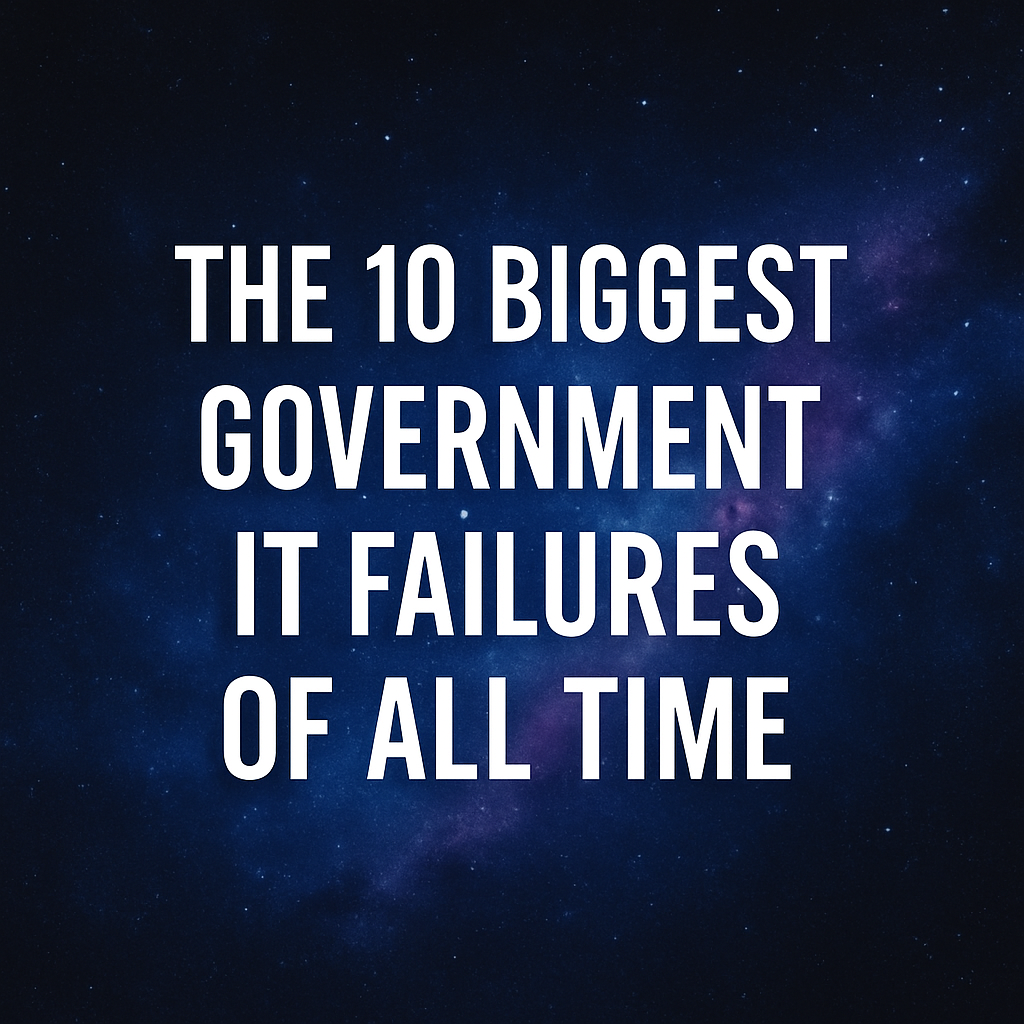Government agencies have some of the most complex digital transformation challenges in the world. Between strict procurement rules, public accountability, entrenched processes, and sprawling stakeholder groups, the stakes are high — and so are the risks.
Over the past few decades, we’ve seen a number of public-sector ERP and IT projects collapse under their own weight. The result? Cost overruns, delayed timelines, operational breakdowns, and in some cases, outright scandals.
Based on magnitude, visibility, and impact, here are the 10 biggest government IT failures of all time — and what you can learn from them.
Table of Contents
Toggle10. Illinois & Cook County Modernization — Tyler Technologies
- Goal: Modernize tax filing, court, and other systems.
- Planned Cost: $75M → Actual Cost: $300M
- Fallout: Delayed tax refunds, court backlogs, negative citizen impact.
- Lesson: A modern tech stack means little if citizen services grind to a halt.
9. FBI Virtual Case File — SAIC
- Goal: Track terrorist threats and watch-list suspects post-9/11.
- Spent: $170M before cancellation.
- Outcome: Never went live; follow-up implementation also failed.
- Lesson: Outdated architecture and shifting requirements can sink even the most urgent projects.
8. NYC CityTime Payroll System — SAIC → IBM
- Planned Cost: $63M → Actual Cost: ~$700M.
- Scandal: 11 fraud convictions, $500M settlement from SAIC.
- Lesson: Weak oversight can lead to runaway costs — and even criminal activity.
7. U.S. Department of Defense HR/Payroll — Oracle PeopleSoft with Northrop Grumman
- Duration: 13 years → Cancelled.
- Cost: $1B+ with no results.
- Lesson: Without executive sponsorship and defined requirements, big-budget projects stall indefinitely.
6. U.S. Air Force ERP Consolidation — Oracle ERP with CSC
- Goal: Merge 240 systems into one.
- Cost: $1B+ over 7 years → Never went live.
- Lesson: Excessive customization and weak governance are a recipe for failure.
5. Queensland Health Payroll — SAP with IBM
- Planned Cost: $6M AUD → Actual Cost: $1.2B AUD.
- Impact: Employees not paid; labeled Australia’s “worst IT investment.”
- Lesson: Payroll errors damage more than finances — they destroy trust.
4. U.S. Virtual Fence — Boeing
- Goal: Border security with sensors and software.
- Cost: $1.4B for just 23 miles of coverage before cancellation.
- Lesson: Technology must match operational reality; integration issues can sink physical + digital projects.
3. UK Post Office Horizon — Fujitsu
- Cost: $1B+
- Scandal: 700+ wrongful convictions for false cash shortfalls.
- Lesson: Denying system flaws compounds technical failures with legal and reputational crises.
2. Canada Phoenix Pay System — Oracle PeopleSoft with IBM
- Cost: $3.5B CAD and counting.
- Status: Still not live; 80% of employees experienced payroll issues.
- Lesson: Scale amplifies mistakes; payroll modernization requires meticulous testing.
1. UK NHS National Programme for IT — Lorenzo EHR with multiple integrators
- Planned Cost: £6.4B → Actual: £10B.
- Outcome: Cancelled in 2011; delivered limited results.
- Lesson: The largest IT program in UK history became its most infamous failure.
The Common Threads Behind Public Sector IT Failures
These projects failed for many of the same reasons:
- Lack of Change Management — Technology adoption is a human challenge first.
- No Vendor Accountability — “Open checkbook” relationships with SIs rarely end well.
- Unrealistic Budgets & Timelines — Overpromising early leads to underdelivering later.
- Weak Governance — Without strong oversight, scope and costs spiral.
- Excessive Customization — The more you rewrite the software, the more fragile it becomes.
- Politically Driven Procurement — Well-intentioned but flawed selection processes introduce risk from day one.
How Government Agencies Can Avoid These Pitfalls
- Establish independent oversight outside of vendor influence.
- Invest early in organizational change management.
- Align technology decisions with long-term operational strategy.
- Validate procurement processes against real-world delivery metrics.
- Resist unnecessary customization unless it’s mission-critical.
Learn More
For a deeper dive into public sector technology modernization — including case studies of successful implementations — download our free Government Digital Transformation Report.
Q&A: Government IT Failures & Lessons Learned
Q: Why do so many government ERP and IT projects fail?
A: Common reasons include lack of change management, weak governance, unrealistic budgets and timelines, excessive customization, and politically driven procurement decisions. Many agencies also fail to hold system integrators accountable, creating “open checkbook” situations that spiral costs.
Q: Are government ERP failures unique compared to private sector projects?
A: Yes and no. The core challenges—poor planning, vendor misalignment, and change resistance—exist everywhere. But government projects often have extra layers of bureaucracy, political influence, and public scrutiny, which magnify the risks.
Q: Which was the most expensive government IT failure of all time?
A: The UK NHS National Programme for IT, costing over £10 billion, is widely regarded as the largest and most costly IT failure in UK history.
Q: What’s the most common technical mistake in these failures?
A: Excessive software customization. When agencies try to make new ERP or IT systems replicate every detail of old workflows, they create fragile, overcomplicated systems that are hard to maintain.
Q: How can public sector agencies avoid ERP and IT failure?
A: Start with a clear strategy and strong governance, keep customization to a minimum, invest heavily in organizational change management, and use independent oversight to keep vendors accountable.
Q: Where can I learn more about successful government IT transformations?
A: Download our free Government Digital Transformation Report for case studies, lessons learned, and proven strategies from agencies that got it right.






